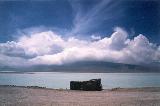Climbing Volcan Licancabur (5916m)
Bolivia/Chile
Rising one kilometer above the Altiplano at the
Bolivian/Chilean border, Licancabur resembles an almost perfect volcano.
Its impressive symmetric cone shape can easily be seen from San Pedro de
Atacama.
Together with Sergio Ortolani and Benoit
Joguet I planned to try the climb within a few days in March 1999. We
traveled to San Pedro where we found a
bolivian agency to bring us across the border to Laguna Blanca.
Here at the bolivian side the normal route leads up the
steep side of the volcano.
(Click on the thumbnails for the larger images.)

The "perfect" volcano.
On our first day in San Pedro we were disappointed because the clouds
didn't allow us a view to our goal. After driving one hour in the
direction of the border, the clouds suddenly gave way to
this beautiful sight of the high craterrim of Licancabur.

The refugios at Laguna Blanca in Bolivia at 4300m.
The next morning we boarded a minibus in San Pedro and were brought to
this place at the shores of Laguna Blanca,
where we spent the night. Licancabur is visible in the back to the
left with a funny cloud above its crater.

The normal route to reach the summit of Licancabur is located on this
side of the mountain. Obviousily there would be no snow at all along the
way.

"Laguna Verde"
Right beside Laguna Blanca and even closer to Licancabur lies Laguna
Verde. The two Lagunas contribute a lot to the unearthy scenery of
this place. The starting point of the climb, the "Ruinas de Inca" at
4700m, is close to the saddle in the right background.

"Bolivian Winter"
Although summertime in the southern hemisphere, the so-called 'Bolivian
Winter' means quite the opposite: unstable weather conditions and heavy
clouds coming in from the direction of Bolivia. The little building in the
foreground is a very important and frequently visited place at altitude.
We met another climber, Antonio from Spain, who wanted to join us
for the next day. The day before he had climbed the other lower
volcano beside Licancabur, so we didn't expect to keep track with him.
We agreed on a wake-up time and after drinking our share of
Coca tea we went to sleep. At 2 am we had breakfast and after a short
drive to the Ruinas de Inca we finally started the climb in darkness.
The weather looked fine and it was surprisingly warm (better to say, not
too cold), the mountain loomed as a huge black triangle above us.

"Sunrise"
After climbing some time in the dark, the rising sun laid an orange
light over the mountainside. Here you can see Sergio taking a little
break.

The route is extremely straightforward. There are almost no switchbacks
and the loose gravel makes it quite frustrating sometimes. As
expected we couldn't keep track with Antonio who was simply too fast
for us.

Looking down the way we came. In the background to the left is the
second volcano beside Licancabur.

Sergio climbing the exhausting and steep path.

Laguna Verde and Blanca seen from high up on Licancabur.
We made just little progress and started thinking about turning around.

Antonio was already on his way back from the summit when we met again and
he told me that it is just another hour to the top. With new energy I
pushed forward to Benoit who was ahead and while the first clouds were
coming in we climbed closer to the craterrim. Because of the unsecure
weather situation Sergio decided to turn around.

And suddenly after another hour of slow and exhausting climbing I was
looking down into the crater-lake of Licancabur! Somewhere I have read
that this is the highest lake of the world! Also some
Inca ruines are located nearby on the craterrim. Meanwhile clouds were
covering the mountaintop and I couldn't enjoy the spectacular view from
up there.

Benoit approaching the summit.

Together at the top. On the way down we had big troubles with thick fog
at the lower part of the route. Soon we were lost but fortunately were
found by one of the boys from the travel agency, who led us back to
the waiting car. On the same evening we returned to San Pedro.
Links to other Licancabur sites:
Claudio Seebach's Licancabur page
BACK to
the mountain-page













